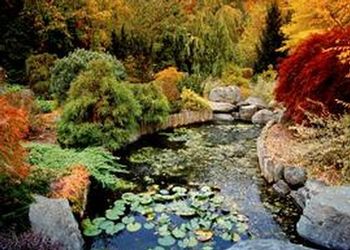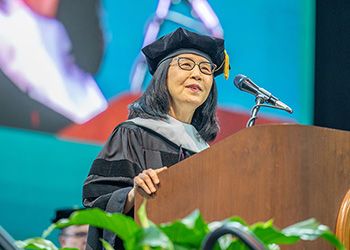MSU Horticulture Gardens
Gifts of beauty and purpose
February 26, 2014
Donors helped build MSU’s 14-acre Horticultural Gardens 20 years ago, with lasting impact. To this day, there is nothing quite like these gardens that have helped to make Michigan the third-largest state for floriculture crops, transformed the concept of a public children’s garden across the world, supported groundbreaking teaching and research, and delighted and inspired countless visitors.
Fundraising began in 1987, and, with the dedication of many, $3 million had been raised by the time the gardens were dedicated in 1993.
“The number of donors who came to the rescue made all the difference. We are here because of their generosity and vision,” says Professor and Horticultural Gardens Director Art Cameron.
The gardens are widely considered to be one of the top university horticulture gardens in the country. In their scope and size, they stand alone in being centrally located on a campus.
A new way to share plants with children
While the Horticultural Gardens were a massive undertaking on their own, former horticulture faculty member Jane Taylor came up with the idea for a children’s garden and independently raised an additional $2.5 million for the project. The effort helped revolutionize the look, shape and scope of public children’s gardensacross the U.S. and beyond. Before MSU’s children’s garden, a typical children’s garden was designed for children to look but not touch. Jane wanted to turn that upside down.
With her MSU colleagues and just a half-acre of space, she created 56 theme gardens around the things kids know and love such as Peter Rabbit, rainbows and pizza. The result is dozens of outlets for imaginative play and hands-on exploration.
“The 4-H Children’s Garden was the first of its kind and is still the model on which others are built,” says Art.
Opening flower growing for Michigan
Former Horticulture Professor Will Carlson, who died in 2010, was the champion behind the gardens and the founding curator, first envisioning the gardens in the early 1980s. He believed that the gardens could play an important role in the bedding (flowering annuals from seed) and landscape industry through the testing of new species and products before they went into the market.
Michigan is the third-largest state for floriculture crops, after California and Florida. While those two large sunny states have natural climatic advantages, cold, cloudy Michigan would have seemed unlikely to emerge as third.
As an ambitious new floriculture Extension agent at MSU in the 1960s, Will began urging vegetable growers, who were losing business to farmers in the South and West, to start producing bedding plants, says GreenhouseGrower.com in a tribute to Dr. Carlson.
While most university floriculture programs were focused on fresh cut flowers, blooming potted plants and potted foliage, Will believed bedding plants had the potential to be the next big wave in horticulture. He was right. And the gardens were one of the many ways he continued to influence the bedding plant industry in Michigan and beyond.
“Will was the heart and soul of the formation of the gardens,” says Art. “Without his drive to create a world-class garden here on campus, it wouldn’t have happened.”
The floral peacock, depicted on the cover of this issue, a mainstay in the gardens, is affectionately named “Will” in his honor.
Hands-on learning, research and inspiration
For MSU junior Michael McCallum, the gardens helped determine a career direction. About 18 months into a journalism degree, Michael found himself dreading his writing assignments and, increasingly, finding consolation in spending time at the gardens.
“One day it dawned on me that plants were what I really loved,” he says.
He changed his major to horticulture and now has his eye on becoming a vineyard manager, and eventually an owner.
Of course the gardens offer an array of plant and soil science resources for MSU students to see first hand many of the concepts they are exploring in their courses.
“For putting into practice what you learn, nothing can replace these gardens,” Michael says.
The gardens also play a role in the larger research mission of the university. Many federal grants require an outreach and education component. The gardens can make the difference in securing funding as MSU scientists have the opportunity to partner with the gardens—and their thousands of visitors—to learn how to make scientific information more accessible.
Today, more than 100,000 people visit the MSU Horticulture Gardens on an annual basis, including horticulture industry leaders and home gardeners, school children and college students, wedding guests and birthday party attendees, and all those looking for a beautiful respite.
For more information on making a gift to the Horticultural Gardens, contact Assistant Director of Development Samantha Adler at adlersa2@msu.edu; 517-353-4749.
The Judy DeLapa Perennial Garden
As she approached a certain birthday twenty years ago, Judy DeLapa (’59, ’85, Home Economics Education and Family Studies) gave her husband Jim DeLapa (’58, Business) strict instructions: no big party—a quiet family dinner will be just fine, thank you.
When her son, Jim and his wife, Kim, who live in San Diego and never, EVER visit in the winter time showed up on their snowy doorstep for her February birthday, she knew something was up. The rest of the family was already in the kitchen preparing dinner. Toward the end of dinner, son, Jim, began talking about her lifetime love of flowers.
The next thing she expected to see was flowers; not a large architectural drawing—the landscape plans for the Judith A. DeLapa Perennial Garden in the MSU Horticulture Gardens. For months, without Judy’s knowledge, Jim Sr., son Tony & his wife, Linda, Jim II and Kim, son John and daughter Gina had planned and supported this gift of a lifetime for Judy. Among this happy family are six graduates of MSU and more recently their grandson, Justin.
“Jim and I had talked about doing something for MSU in our lifetime,” Judy says. “I wanted it to be something that people from all walks of life could enjoy. Truly, the family could not have selected a more lovely or fitting tribute.”
Judy and Jim also provide scholarships for MSU students through the Resource Center for Students with Disabilities. To date, 60 students have directly benefitted from their generosity. In 2013 Judy was awarded the first annual MSU Spirit of Ability Award by RCPD.
Within a few years after graduating MSU, Judy and Jim combined their knowledge of food preparation and production and opened a take-out pizzeria in a converted garage with an initial investment of $2000.
Thirteen years later after expanding into the frozen pizza business and with nearly 300 employees and sales distribution in 18 states, General Mills acquired their business.
Judy, who works as an executive coach, and Jim, retired General Mills executive, travel from their Grand Rapids home to visit the gardens regularly.
When Judy sees the plaque with her name, she says:
“The Judith A. DeLapa Perennial Garden serves as a reminder of my life’s purpose: to help others maximize their abilities and show them how to open doors of opportunity in their work and in their lives. The garden is a living tribute to who I am and I shall always be grateful to my family for honoring me in this way.”




